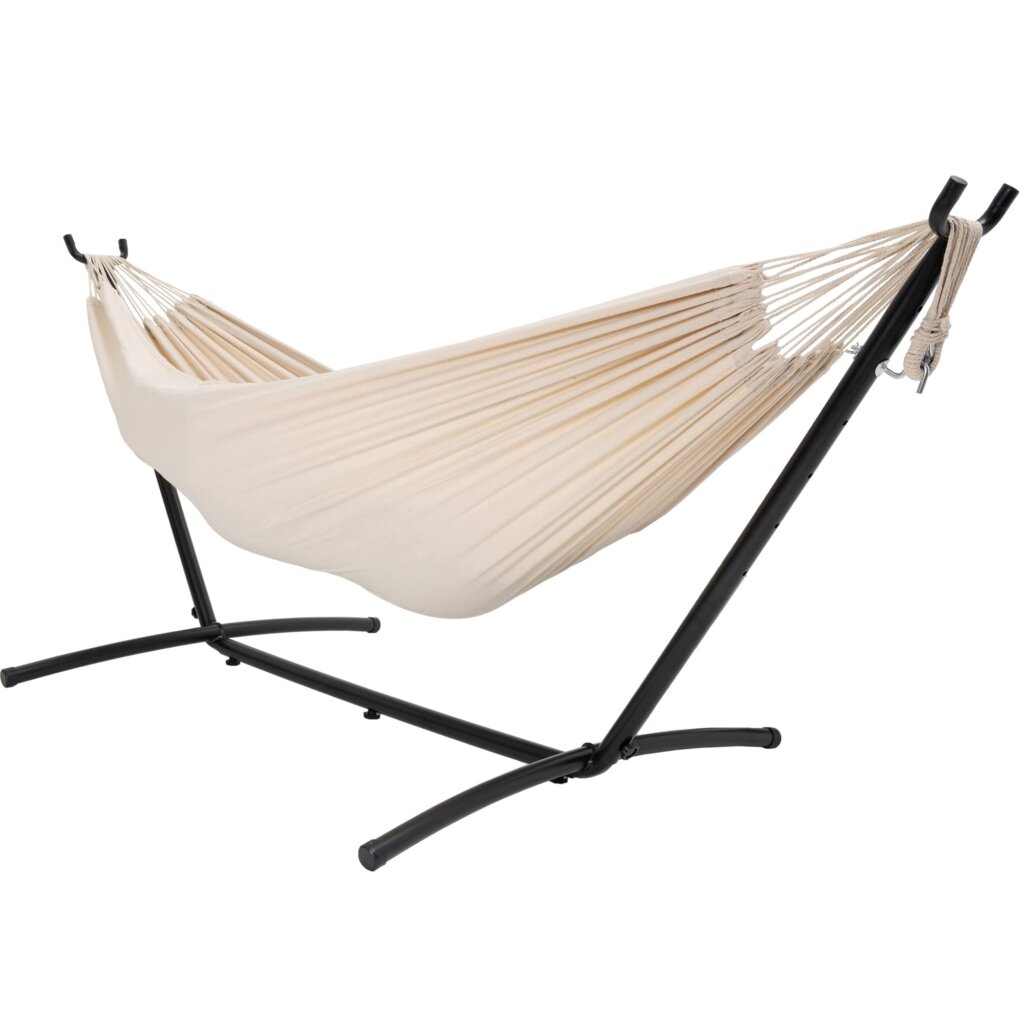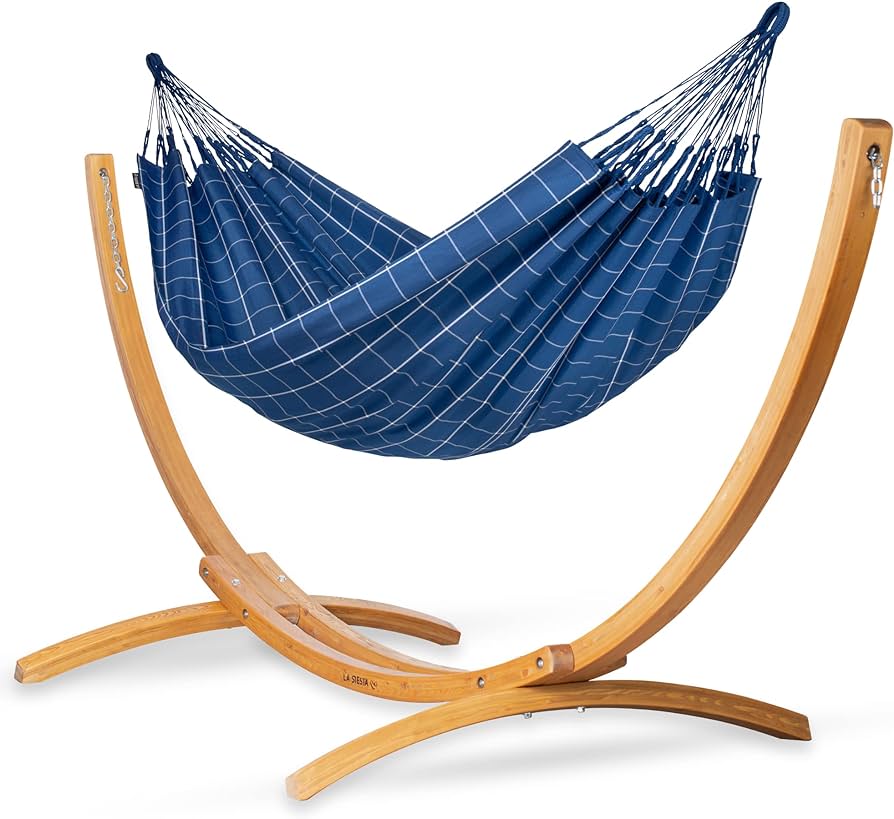- 8 Airplane Footrest Hammock!Travel comfortably - October 9, 2023
- top 7 Pool Float Water Hammock for a Relaxing Summer - October 9, 2023
- top 5 Space SaverSingle Hammock Stand Maximize Comfort and Space - October 9, 2023
Hammock posts need to be spaced 10-15 feet apart. Hanging a hammock requires two sturdy posts, typically made of wood or metal, that are securely rooted in the ground and positioned at an appropriate distance.
Adequate spacing ensures that the hammock remains stable and provides a comfortable and secure lounging experience. When installing hammock posts, it is crucial to consider the length of the hammock and the weight it will bear. Understanding the proper spacing between posts is essential for enjoying a relaxing hammock experience in a safe and secure manner.
Factors To Consider For Hammock Post Spacing
When it comes to setting up a hammock, one of the most important factors to consider is the spacing between the hammock posts. The distance between the posts determines the stability and comfort of your hammock setup. There are several factors that you need to take into account to ensure the correct spacing.
The Length of the Hammock
The length of your hammock plays a crucial role in determining the spacing between the posts. Typically, the distance between the posts should be equal to the overall length of the hammock. This ensures that the hammock is evenly supported and allows for proper weight distribution. If you have a longer hammock, you will need to space the posts farther apart, while a shorter hammock will require them to be closer together.
Suspension System Type
Another factor to consider is the type of suspension system you have for your hammock. Different suspension systems require different post spacing. For example, if you have a hammock with a spreader bar, you will need to space the posts farther apart to accommodate the width of the hammock. On the other hand, if you have a gathered-end or parachute-style hammock, you can space the posts closer together since the hammock will naturally sag and conform to the distance between the posts.
Desired Sag or Hang Angle
The desired sag or hang angle of your hammock also affects the post spacing. A hammock that is hung with a shallower sag or hang angle will require the posts to be closer together. Conversely, a hammock with a deeper sag or hang angle will need the posts to be spaced farther apart. The sag or hang angle not only affects the comfort of your hammock but also the stress on the posts and the overall stability of the setup.
In summary, when determining the spacing between hammock posts, consider the length of the hammock, the type of suspension system you have, and the desired sag or hang angle. By taking these factors into account, you can ensure a comfortable and secure hammock setup.
Determining The Ideal Distance Between Hammock Posts
Calculating the hammock length and sag
When it comes to hanging a hammock between two posts, determining the ideal distance is crucial for a comfortable and enjoyable experience. One of the key factors in calculating this distance is understanding the length and sag of your hammock. The length of the hammock refers to the measurement from one end to the other, while the sag is the amount of dip or curve the hammock has when it is hung.
Measuring the length of the hammock
To start calculating the distance between the hammock posts, you need to measure the length of your hammock. This can be done by laying the hammock flat on the ground and measuring from one end to the other. Be sure to include any attachment points, such as carabiners or ropes, in your measurement. By getting an accurate length measurement, you can ensure that your hammock will fit comfortably when hung between the posts.
Considering the desired sag for comfort
The sag of the hammock plays a significant role in determining the distance between the posts. The ideal sag is subjective and varies depending on personal preference. Some hammock enthusiasts prefer a deeper sag for a more relaxed and cocoon-like feel, while others prefer a shallower sag for a firmer and more supportive position. Consider your comfort preferences when deciding on the desired sag for your hammock and keep it in mind when calculating the distance between the posts.
Calculating the total distance needed
To calculate the total distance needed between the hammock posts, you can use a simple formula. Add the length of your hammock to twice the desired sag. For example, if your hammock is 9 feet long and you want a 1-foot sag, you would need a distance of 11 feet between the posts (9 feet + (2 x 1 foot) = 11 feet).
It’s important to note that this formula provides a general guideline, and factors such as the stretchiness of the hammock fabric and the weight of the person using the hammock can impact the ideal distance. It’s recommended to test and adjust the distance as needed to achieve the desired comfort level.
By following these steps and calculations, you can determine the ideal distance between your hammock posts, ensuring a comfortable and relaxing experience every time you hang your hammock.
Safety Considerations For Hammock Post Spacing
When setting up a hammock, one of the most important factors to consider is the spacing between the hammock posts. The correct distance will not only ensure comfort and support, but also plays a vital role in the overall safety of the setup. To create a safe and secure environment, it is crucial to take into account the weight capacity and load-bearing capacity, stability of the posts and anchoring, as well as other factors that can affect stability.
Weight Capacity and Load-Bearing
The weight capacity and load-bearing capacity of the hammock posts are of utmost importance when it comes to safety. You want to make sure that the posts are able to support the weight of the hammock, as well as the weight of anyone who may be using it. The weight capacity is typically specified by the manufacturer and can vary depending on the type of hammock. It is important to check the weight capacity and ensure that the posts are able to accommodate the intended load.
Stability of Posts and Anchoring
The stability of the posts and the way they are anchored also play a significant role in the safety of the hammock setup. The posts should be securely anchored into the ground or other supporting structures to prevent any wobbling or tipping over. This can be achieved by using appropriate hardware and following the manufacturer’s guidelines for installation. Additionally, it is important to regularly inspect the posts and their anchoring to ensure that they remain stable over time.
Factors Affecting Stability
There are various factors that can affect the stability of a hammock setup, ranging from external elements such as wind, to soil conditions, and even the type of terrain. Strong winds can exert considerable force on the hammock and posts, so it is important to choose a sheltered location or use additional support measures, such as guy lines or extra anchor points. The type and condition of the soil also play a role, as loose or sandy soil may not provide adequate support for the posts. It is advisable to choose a firm and stable ground for installation. Finally, uneven or sloping terrain can affect the balance and stability of the hammock, so it is important to ensure that the posts are properly aligned to maintain a level sleeping surface.
Tips For Installing Hammock Posts
Installing hammock posts may seem like a straightforward task, but there are important considerations to ensure stability and longevity. From selecting suitable post materials to applying protective coatings, each step plays a crucial role in creating a secure and comfortable hammock setup.
Selecting suitable post materials
When it comes to selecting the right materials for your hammock posts, there are a few options to consider. Wooden posts are a popular choice, providing a natural look and sturdy support. Cedar, cypress, or pressure-treated wood are excellent options due to their resistance to rot and insect damage. Alternatively, metal posts such as steel, aluminum, or galvanized steel offer durability and strength.
Digging the holes for the posts
Digging the holes for your hammock posts is a crucial step in ensuring stability. It is recommended to dig holes that are at least 2 feet deep in order to provide a solid foundation. The diameter of the holes should be approximately twice the width of your post for optimal stability. Use a post hole digger or a shovel to create the holes, ensuring they are evenly spaced apart to match the dimensions of your hammock.
Depth and diameter considerations
The depth and diameter of the holes play a significant role in the overall strength and stability of the hammock posts. The deeper the holes, the better the stability, as it provides more support for the weight applied to the posts. Additionally, wider diameter holes allow for the use of concrete or gravel to secure the posts firmly in place.
Setting the posts securely
After digging the holes, it’s essential to properly set the posts in place. If using wooden posts, ensure they are properly aligned and level before filling the hole with concrete or gravel. Use a level to check for any unevenness and make adjustments as necessary. With metal posts, follow the manufacturer’s instructions to securely attach them to the ground using appropriate hardware.
Applying protective coatings or treatments
Applying protective coatings or treatments to your hammock posts is essential to prolong their lifespan. Natural wood posts can be treated with a weather-resistant sealant or stained to enhance their resistance to the elements. Metal posts can be painted or coated with rust-resistant materials to prevent corrosion.
By following these tips for installing hammock posts, you can create a secure and comfortable setup that will withstand the test of time. Remember to consider factors such as suitable post materials, hole depth and diameter, securely setting the posts, and applying protective coatings. With proper installation, you can enjoy peaceful and relaxing moments in your hammock for years to come.
Alternatives To Traditional Hammock Posts
Using existing structures as anchor points
One alternative to traditional hammock posts is utilizing existing structures as anchor points. This can be a great option if you have sturdy trees or sturdy posts already in place in your backyard. By attaching your hammock to these existing structures, you can save time and money on installing new posts.
To use existing structures as anchor points for your hammock, it’s important to ensure that they are strong enough to support the weight and tension of the hammock. Trees should have thick trunks and branches that are at least 12 inches in diameter. Posts should be made of durable materials such as metal or treated wood.
When attaching your hammock to existing structures, you can use hammock straps or ropes that are specifically designed for outdoor use. These will provide a secure and stable attachment point for your hammock.
Installing hammock stands
If you don’t have any existing structures to use as anchor points, another alternative is to install hammock stands. Hammock stands are freestanding structures that are specifically designed to hold hammocks.
When installing hammock stands, it’s important to choose a location that is flat and level. This will ensure stability and prevent the stand from tipping over. You should also consider the weight capacity of the stand to ensure it can safely support your weight.
Hammock stands come in a variety of materials, including metal and wood. Metal stands are generally more durable and weather-resistant, while wooden stands can add a natural and aesthetic touch to your backyard. Choose a stand that suits your preferences and complements your outdoor space.
Utilizing adjustable suspension systems
Another option for setting up your hammock is by utilizing adjustable suspension systems. These systems allow you to easily adjust the tension and height of your hammock without the need for traditional posts or stands.
There are various types of adjustable suspension systems available, such as hammock straps with multiple attachment points or adjustable ropes with carabiners. These systems provide flexibility and customization, allowing you to find the perfect hanging position for your hammock.
When using adjustable suspension systems, it’s important to follow the manufacturer’s instructions for proper installation and usage. Ensure that the straps or ropes are securely attached to anchor points that can support the weight of the hammock, such as trees or posts.
By incorporating these alternatives to traditional hammock posts into your outdoor setup, you can enjoy the relaxation and comfort of a hammock without the need for extensive installation or construction. Whether you choose to use existing structures, install hammock stands, or utilize adjustable suspension systems, finding the perfect setup for your hammock is within reach.

Credit: momcandoanything.com
Maintenance And Longevity Of Hammock Posts
Regular inspections and maintenance
Regular inspections and maintenance are crucial for ensuring the longevity of your hammock posts. By conducting routine inspections, you can identify any signs of damage or wear and tear early on, allowing you to take appropriate actions to prevent further deterioration. Inspect the posts for cracks, splintering, or any signs of weakness. Additionally, make sure the posts are securely anchored to the ground to avoid any accidents or injuries. Regular maintenance includes cleaning the posts and applying a protective finish to keep them looking good and resistant to environmental elements. Remember, a well-maintained hammock post will provide you with years of relaxation and enjoyment.
Repairing or replacing damaged posts
If you notice any damage to your hammock posts during inspections, it is essential to promptly address the issue to prevent further complications. Depending on the severity of the damage, you may be able to repair the post or may need to replace it entirely. Minor cracks or splintering can often be repaired by filling the gaps with wood putty and sanding down the affected area. However, if the damage is extensive or compromises the structural integrity of the post, it is recommended to replace it. Ignoring damaged posts can lead to safety hazards and decrease the overall lifespan of your hammock setup.
Protecting posts from weather and pests
To ensure the longevity of your hammock posts, it is crucial to protect them from weather conditions and pests. Exposure to rain, snow, and UV rays can cause the wood to deteriorate faster. Applying a weather-resistant sealant or stain can help protect the wood from moisture and sun damage. Additionally, pests such as termites and wood-boring insects can cause significant damage to the posts. Consider treating the wood with a pest-resistant product to prevent infestations and regularly inspect for any signs of pest activity. Taking these preventive measures will help extend the lifespan of your hammock posts and ensure your outdoor relaxation space stays in great condition for years to come.
Frequently Asked Questions Of How Far Apart Do Hammock Posts Need To Be
How Far Apart Are The Posts For A Hammock?
The posts for a hammock should be spaced equal to the overall length of the hammock.
Should I Use 4X4 Or 6X6 Posts For Hammock?
For optimal stability and support, it is recommended to use 6×6 posts for hammocks. This ensures that the posts can bear the weight and prevent any sagging or swaying.
Will A 6X6 Post Hold A Hammock?
Yes, a 6×6 post will hold a hammock.
Can You Hang A Hammock From A 4X4 Post?
Yes, you can hang a hammock from a 4×4 post.
How Far Apart Should Hammock Posts Be For Optimal Comfort?
For optimal comfort, hammock posts should be placed approximately 14-16 feet apart. This distance ensures proper tension and support for a relaxing experience.
Why Is It Important To Consider The Distance Between Hammock Posts?
The distance between hammock posts is important because it affects the stability and comfort of the hammock. By placing the posts at the right distance, you can create the perfect balance for a comfortable hammocking experience.
Conclusion
The distance between hammock posts will depend on the overall length of your hammock. As a general rule, the average hammock requires up to 15 square feet of space, with double hammocks needing around 20 square feet. When installing your hammock, make sure to consider the depth of the holes and the height of the posts.
By following these guidelines, you can create the perfect space for relaxing and enjoying your hammock.





